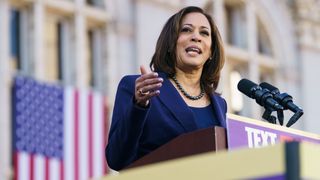Kamala Harris’ ascent to the top of the Democratic ticket has shaken up the 2024 US presidential race and injected fresh life into the Democrats’ bid for the White House.
Just three weeks ago, 81-year-old President Joe Biden was muddling through media appearances and press conference gaffes, all the while struggling to hold onto support from traditional Democratic constituencies, let alone from within his own party.
The Democrats can now taste what was slipping away in the dying days of Biden’s campaign — a path forward to victory in November.
It’s difficult to overstate just how much Harris is energising the Democratic base.
Her entry into the race catalysed one of the largest fundraising spikes in US electoral history, bringing in US$81 million in just 24 hours — most of it from first-time donors. Harris’ recent campaign blitz touring battleground states, with her newly minted running mate Tim Walz, drew crowds of a size and spirit not typically seen until far closer to election day. And that’s not to mention how she is gaining traction online, as users take to social media to memeify her campaign, stitching together videos of Harris with gen Z pop culture touchpoints. Some are even comparing the surge of enthusiasm for Harris to the wave of excitement that surrounded Obama’s campaign in the 2008 presidential election, which he went on to win in an electoral vote landslide.
Recent polling suggests that this new momentum is translating into shifts in voter sentiment. The latest New York Times/Siena poll finds an almost 30-point jump in Democrats’ satisfaction about the choice of candidates this election compared to May, and confirms that Harris is winning back the key Democratic voting blocs that Biden was failing to consolidate, like Black and young voters.
But beyond energising the base, Harris is also making crucial ground in the all-important swing states which will ultimately decide the election. Polling is beginning to show Harris opening a four-point lead in Michigan, Wisconsin and Pennsylvania. These three “Blue Wall” states, in which Biden was haemorrhaging support, all voted for Trump in 2016 and flipped to Biden in 2020. If Harris can continue this trajectory and win these critical states in November, she has perhaps her clearest path to the Oval Office.
There’s no doubt that Trump and his allies can feel this sudden tidal wave of momentum shifting Harris’ way — and it’s placing them under pressure. Just last month, Trump was officially crowned the Republican nominee at an RNC that some suggested felt more like a religious ceremony than a party convention. Most commentary expected Trump to trounce Biden in an electoral rematch; he survived an assassination attempt which only seemed to energise Republicans, and Trump’s choice of JD Vance as a running mate was interpreted by many as a sign that Trump felt he needed to do little to expand his appeal beyond the base of voters already in his grasp.
Now, Trump must compete with Harris for the media oxygen he thrives on. And Harris’ rise is unleashing Trump’s harshest impulses, as he levels personal attacks and questions her racial identity. His campaign has so far failed to land on its messaging — is Harris a “radical San Francisco liberal,” a continuation of Biden’s legislative agenda, or a “flip-flopper” running a “fraudulent campaign”?
It’s no secret that Trump doesn’t do well on the back foot. And if his campaign fails to adapt to Harris’ jolt to the election, it will struggle to blunt the momentum that has propelled her from strength to strength in recent weeks.
However, this is not to say that Democrats are certain to soar to an electoral victory in November. In 2019, Harris burst onto the Democratic primary scene with a groundswell of enthusiasm, but ultimately failed to deliver on the early promise of her campaign. She currently benefits from being a new face in a contest that Americans were increasingly bored of — but there’s only so much longer before the novelty may wear off.
The upcoming weeks therefore represent a crucial test.
Harris’ campaign has yet to lay out a specific policy agenda. But this ambiguity carries risk. Republicans are already filling the void with the left-wing positions from her previous primary run — like banning fracking and abolishing private health insurance — which she’s tried to distance herself from, and are out of step with the views of most moderate voters. Moreover, no amount of momentum can help Harris escape the fact she is tied to Biden’s record on immigration and the economy — two issues that matter most to the Americans she needs to win over in swing states.
But while it may be early days, with Harris at the top of the ticket, pundits can now say what they couldn’t necessarily about Biden’s campaign: the Democrats have a fighting chance in November.
Yes — the Democrats could win: Ava Kalinauskas in Crikey
This article was first published in Crikey.









